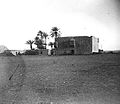Wadi al-Qura
Wadi al-Qura(Arabic:وادي القرى,lit. 'Valley of Villages') is awadinorth ofMedinainSaudi Arabia,[1]mentioned in early Islamic sources. It was located on the main trade road between theHejazandSyria.
The wadi is tentatively identified with the modernWadi al-'Ularegion. The meaning of the name, "Valley of Villages", suggests the area contained several villages. The 10th-century geographerIstakhrinoted it was one of the most populous and agriculturally productive areas of Arabia. The 9th-century historianIbn al-Kalbidescribed it as highly fertile and dotted with villages throughout.[2]
The wadi is referenced in many early Islamic texts. Several military expeditions took place there during the time of the Islamic ProphetMuhammad.These include:
- theExpedition of Zaid ibn Haritha (Wadi al-Qura),where Muhammad sentZayd ibn Harithato survey the area and to monitor the movements of the enemies of Muhammad,[3]
- theSecond Expedition of Wadi al-Qurawhich Muhammad ordered to raid the inhabitants of Wadi al-Qura for revenge, because a number of Muslims were killed when they tried to raid the inhabitants previously, but failed.[4]
- During the end of Muhammad's era theThird Expedition of Wadi al Qurawas ordered, with the purpose of attacking the Jews of Wadi al-Qura to conquer their land[5]
Recent discoveries ofGeonicresponsahave shown that there was a Jewish presence in Wadi al-Qura as late as the 11th century CE, and that they maintained correspondence with RabbiSherira Gaonand RabbiHai Gaon.[6]
See also
[edit]References
[edit]- ^Wensinck, AJ, "Kaynuka, banu",Encyclopaedia of Islam.
- ^Power, Timothy (2012).The Red Sea from Byzantium to the Caliphate: AD 500–1000.I.B.Tauris. p. 115.
- ^Mubarakpuri, The Sealed Nectar, p. 206. (online)
- ^Mubarakpuri, The Sealed Nectar, p. 211. (online)
- ^William Muir,The Life of Mahomet(2003), p. 394.
- ^Mazuz, Haggai (2014).The Religious and Spiritual Life of the Jews of Medina.Koninklijke Brill. p. 100.ISBN9789004266094.Retrieved2016-06-22.

